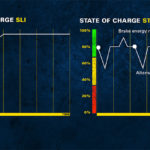 Diodes Incorporated has announced 16-bit PI4IOE5V6416Q and 34-bit PI4IOE5V6534Q bidirectional voltage-level translation general-purpose I/O (GPIO) expanders for automotive applications. Representing an industry first for the automotive industry, the automotive-compliant, AEC-Q100 Grade 2 qualified devices with dual voltage rail provide enhanced programmable I/O for next-generation low voltage microprocessors and microcontrollers via the I2C interface.
Diodes Incorporated has announced 16-bit PI4IOE5V6416Q and 34-bit PI4IOE5V6534Q bidirectional voltage-level translation general-purpose I/O (GPIO) expanders for automotive applications. Representing an industry first for the automotive industry, the automotive-compliant, AEC-Q100 Grade 2 qualified devices with dual voltage rail provide enhanced programmable I/O for next-generation low voltage microprocessors and microcontrollers via the I2C interface.
As part of Diodes’ ongoing expansion into the automotive industry, the new devices provide engineers with a simple solution when additional I/Os are needed while keeping interconnections to a minimum – for example, in ADAS, telematics, and infotainment. Removing the need for an external voltage-level translator simplifies the design of new ADAS and telematics systems, and reduces BOM cost.
Both devices operate from 1.65V to 5.5V on the GPIO port side. On the SCL/SDA side (I2C interface), the PI4IOE5V6416Q operates from 1.65V to 5.5V and the PI4IOE5V6534Q from 0.8V to 3.6V. This dual power rail allows the devices to interface with next-generation low-power microchips on the SCL/SDA side. The expanders offer an exceptionally low standby current consumption of 1.5µA at 5V and 1µA at 3.3V for the PI4IOE5V6416Q and 2µA at 3.3V for the PI4IOE5V6434Q.
Each 16- or 34-bit GPIO on these devices is configurable, and each port features a programmable pull-up or -down resistor and a programmable output current. Unlike many I/O expanders, the PI4IOE5V6416Q and PI4IOE5V6534Q also provide programmable open-drain outputs as part of the enhanced I/O features. The devices have an interrupt masking feature, enabling the designer to mask the interrupt from an individual GPIO port and initiate a system-level action.
The 16-bit PI4IOE5V6416Q is packaged in a 24-pin TSSOP, and the 34-bit PI4IOE5V6534Q is available in the W-QFN4565-46 package. Both devices support PPAP documentation and are manufactured in IATF 16949 certified facilities. The unit price for the 16-bit PI4IOE5V6416Q is $1.80 in 3,000 piece quantities and $2.40 for the 34-bit PI4IOE5V6534Q in 3,500







Leave a Reply